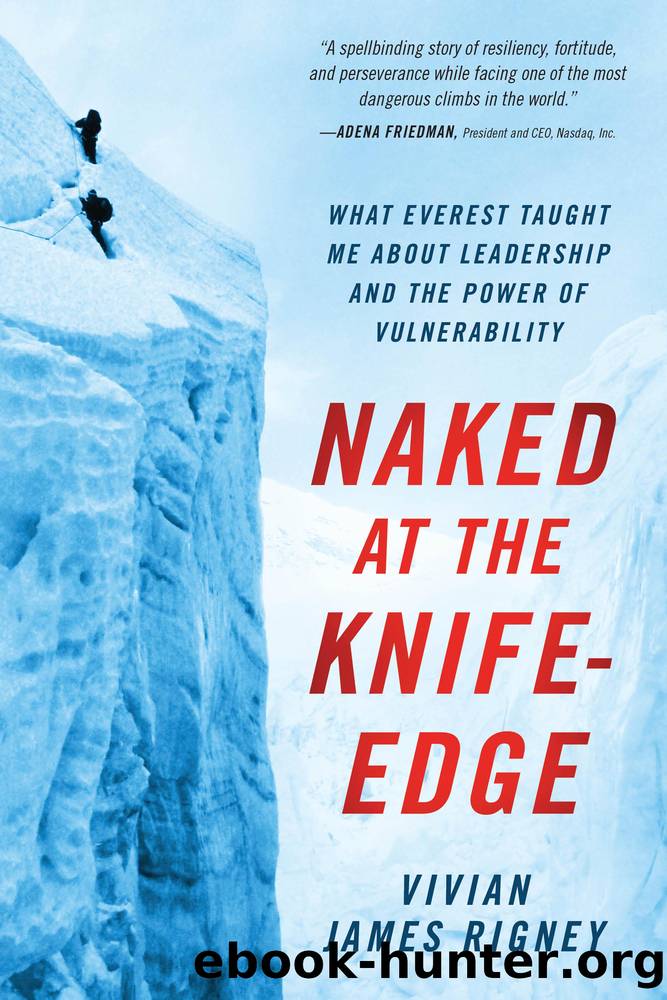Naked at the Knife-Edge by Vivian James Rigney

Author:Vivian James Rigney
Language: eng
Format: epub
Publisher: Forefront Books
Published: 2022-03-08T00:00:00+00:00
CHAPTER 7 HURRY UP AND WAIT
AWAKING TO THE SUNâS DAWN rays warming my tent, I felt as though I had never left Base Camp. It was May 10 and Day 36 of our Everest expedition. With both excitement and trepidation, I walked over to the main tent. Inside it was akin to the Houston Space Center (at least our version of it), and it reminded me of a scene from Apollo 13. Scott and Bill had two laptops open, and there were pages of paper strewn in front of them with colorful weather charts, maps, and satellite images. Scott was on the radio communicating with some of our Sherpa team, who were higher up the mountain, carrying oxygen to the upper camps. His outward demeanor was calm as usual, but his brow was now furrowed and his concentration intense.
âGood morning, Scott here at Base Campâhow are you guys doing? Over.â
The radio crackled. Everyone stared anxiously at the receiver.
Silence.
Scott tried again two more times.
After the third attempt, we heard a roaring wind over the radio, then a voice, heavily panting and out of breath. âGood morning, weâre okay⦠Over.â
âGood to hear. Where are you guys now and what are the conditions? Over. How are the ropes and how far up have they been secured? Over.â
âWeather not good. Very cold here. Making our way to Camp 4. Having tough time with ropes but hope to complete in next days. Over.â
After lunch, Scott and Bill called a meeting and laid out the situation. They had been studying the different forecasts and assessing our options for our summit bid. The good news: a weather window was opening up on May 17, the first decent weather window for the season thus far. The concern, though, was that it was a narrow window with high winds of more than 130 kmh (80 mph), tapering only temporarily before regaining strength. Climbers ideally like to experience gusting winds of less than 50 kmh. Higher wind speedsâespecially coming down, when the body would be at its weakestâmeant an exponentially increased risk of hypothermia, frostbite, and, ultimately, death.
The next possible window was approximately five days later, although any weather window further out would obviously be less accurate and less reliable. This was further complicated by the different weather providers Scott was subscribing to, as each one had its own forecast about when the weather would change. Just like with hurricanes back home in the United States, we had to review a number of models to get a more complete picture of timing, opportunity, and risk. Three core weather elements were essential to the decision-making process and, indeed, our survival: wind, temperature, and precipitation.
Scott had pored over the data and was clearly tempted to go for the earlier window. Time was progressing, and the weather was changing with each day that passed, the air becoming more dense, humid, and unstable. The monsoon season was a massive seasonal occurrence for the whole Indian subcontinent, including the Himalayas, and we could feel it building around us in the increased intensity of the snowstorms at Base Camp.
Download
This site does not store any files on its server. We only index and link to content provided by other sites. Please contact the content providers to delete copyright contents if any and email us, we'll remove relevant links or contents immediately.
Your Money or Your Life by Robin Vicki & Dominguez Joe(867)
The Infographic Guide to Personal Finance by Michele Cagan(834)
The Smart Woman's Guide to Property Law by Carla Spivack(790)
Iconic Australian Houses 506070 by Karen McCartney(710)
Retirement 101 by Michele Cagan(697)
Your Souls Gift - The Healing Power of the Life You Planned Before You Were Born by Robert Schwartz(650)
Money, Possessions, and Eternity by Randy Alcorn(639)
Iconic Australian Houses 708090 by Karen McCartney(628)
Think Your Way to Wealth by Napoleon Hill(608)
Be a Millionaire Next Year by Michael R. Berg(601)
Get Out of Debt Now by allen carr(592)
Choose FI by Chris Mamula & Brad Barrett & Jonathan Mendonsa(586)
Creating Money: Attracting Abundance by Sanaya Roman & Duane Packer(578)
The Mindful Millionaire by Leisa Peterson(574)
21 Days to Master Becoming a Money Magnet by Marie-Claire Carlyle(567)
Mastering Money by Norm Champ(560)
Student Loan Solution by David Carlson(547)
Rich Dad, Poor Dad by Kiyosaki Robert T(516)
Smarter Investing: Simpler Decisions for Better Results by Tim Hale;(501)
